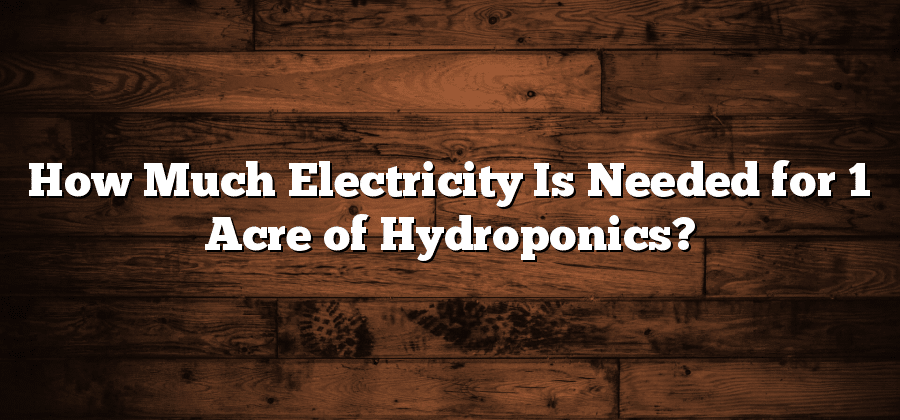Electricity Consumption of Hydroponics Systems
Hydroponics systems have gained popularity in recent years as a sustainable and efficient method of farming. However, it is important to address the electricity consumption associated with these systems. As with any form of agriculture, hydroponics requires a significant amount of energy to power various components such as pumps, fans, and lighting systems. The electricity consumption of hydroponics systems can vary depending on several factors, including the size of the system, the type of crops being grown, and the specific equipment used.
One of the main factors contributing to electricity usage in hydroponics systems is the need for artificial lighting. Unlike traditional farming methods that rely on natural sunlight, hydroponics often requires the use of high-intensity lamps to provide the necessary light spectrum and duration for optimal plant growth. These lighting systems can consume a substantial amount of electricity, particularly in large-scale hydroponic farms where multiple lights are needed. Additionally, the use of climate control systems, such as heaters or coolers, can further contribute to electricity consumption, as maintaining a stable temperature is crucial for plant health and growth in hydroponics.
Overall, understanding the electricity consumption of hydroponics systems is essential for both farmers and policy-makers. By identifying the factors that affect energy usage and exploring strategies to optimize energy efficiency, we can work towards creating more sustainable and environmentally friendly hydroponic farming practices. Balancing productivity with energy consumption is a key challenge in modern agriculture, and finding innovative solutions to reduce electricity usage while still ensuring high crop yields is crucial for the long-term success of hydroponics as a viable farming method.
Factors Affecting Electricity Usage in Hydroponics
Factors Affecting Electricity Usage in Hydroponics:
Lighting plays a vital role in hydroponic systems and is a major contributor to electricity usage. Plants require a specific light spectrum and intensity for optimal growth, and hydroponic farmers often rely on artificial lighting to provide these conditions. The type of lighting used, such as LED or high-pressure sodium (HPS) lamps, can impact electricity consumption. Additionally, the duration and intensity of light exposure also influence electricity usage. It is crucial for hydroponic farmers to carefully assess their lighting needs and consider energy-efficient options to minimize electricity usage without compromising plant growth.
Temperature control is another factor that affects electricity usage in hydroponics. Maintaining the optimal temperature range for plant growth is essential, and this often requires the use of heating or cooling systems, such as heaters, air conditioners, or fans. The efficiency and size of these temperature control systems can significantly impact the overall electricity consumption of a hydroponic system. Proper insulation and ventilation practices can help reduce energy waste and optimize temperature control, ultimately lowering electricity usage. Hydroponic farmers must carefully assess their climate conditions and implement energy-efficient solutions to regulate temperatures effectively.
Optimizing Energy Efficiency in Hydroponic Farming
One key aspect of hydroponic farming is optimizing energy efficiency, as it can significantly impact not only operational costs but also environmental sustainability. There are several strategies that can be employed to achieve this goal. First and foremost, it is crucial to invest in energy-efficient equipment and technologies. This can include using LED lights instead of traditional lighting options, which not only consume less electricity but also emit less heat. Additionally, employing energy-efficient pumps, fans, and heating systems can further reduce energy consumption in the hydroponic system.
Calculating Power Requirements for Hydroponic Systems
Calculating power requirements for hydroponic systems is an essential step in ensuring the efficient use of electricity. To accurately determine the power needs of a hydroponic setup, several factors must be considered. One of the primary factors is the size of the system, including the number of plants and the overall cultivation area.
Additionally, the type of lighting used in the hydroponic system plays a crucial role in power calculations. Different lighting options, such as fluorescent, LED, or high-pressure sodium, have varying energy requirements. The intensity and duration of light also need to be taken into account when determining the power consumption. By accurately calculating power requirements, hydroponic farmers can optimize energy usage, reduce electricity costs, and minimize their environmental impact.
Comparison of Energy Consumption between Traditional and Hydroponic Farming
Traditional farming methods have long relied on the use of fossil fuels for various tasks, such as tilling the soil, operating machinery, and transporting produce. This heavy reliance on non-renewable energy sources has led to significant carbon emissions and environmental degradation. In contrast, hydroponic farming systems have the potential to significantly reduce energy consumption and environmental impact. By using controlled environments, efficient water recirculation systems, and LED lighting technology, hydroponic farms can optimize energy efficiency and minimize waste.
One of the major factors contributing to the higher energy consumption in traditional farming is the extensive use of machinery. From plowing fields to harvesting crops, a variety of heavy equipment is needed to maintain and manage a traditional farm. Additionally, the transportation of produce from rural areas to urban centers further adds to the energy requirements of traditional farming practices. In contrast, hydroponic systems eliminate the need for heavy machinery in tilling, as plants are grown without soil. The controlled environment also reduces the need for manual labor, further decreasing energy consumption. Moreover, hydroponic farms can be established closer to urban centers, reducing the distance and energy required for transportation.
In summary, comparing the energy consumption of traditional and hydroponic farming reveals a stark contrast. Traditional farming methods heavily rely on fossil fuels for equipment operation and produce transportation, resulting in significant energy consumption and environmental impact. On the other hand, hydroponic farming offers the potential for energy-efficient cultivation through the use of controlled environments, resource recycling, and reduced transportation needs. Embracing hydroponics could pave the way for a more sustainable and environmentally friendly approach to food production.






